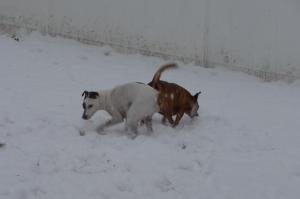Tips for Keeping Outdoor Pets Safe in Cold Temperatures
- posted: Jan. 07, 2018
 Keeping Outdoor Pets Warm in Winter
Keeping Outdoor Pets Warm in Winter
It’s January in Central Pennsylvania and that means pork and sauerkraut, Farm Show snow and cold weather. Since the arrival of the Arctic Super-frigid Snowpocalyptic Blizzard Bomb or whatever crazy euphemism the weather forecasters have come up with for our latest round of sub-zero temperatures, the thoughts of many veterinarians and pet owners alike turn to keeping pets who live outdoors comfortable and warm.
When temperatures hit single digits, the best place for pets to be is indoors. If pets are not allowed in the house, consider allowing them to take shelter in a garage (though make sure pets are not exposed to car fumes, antifreeze or other toxins), a shed or an enclosed porch. Dogs who must remain outdoors must have adequate housing—preferably a raised solid or windproof shelter or dog house with the door facing away from the wind. It should be large enough to comfortably turn around in but small enough to conserve a pet’s body heat. Shelters must also be lined with clean, dry bedding such as straw. Bedding should be deep and dry and changed regularly. Do not use blankets which may become wet or soiled, or heating pads or space heaters which may be fire hazards.
If you have outdoor cats in your neighborhood, small shelters can be built or purchased and lined with straw bedding or pillow cases loosely stuffed with shredded newspaper to allow cats to burrow and trap body heat. Shelters may also be lined with reflective Mylar. Another tip to remember is that outdoor cats may seek shelter from the cold under the hoods of cars. It’s a good idea to rap on your car hood before starting your car to prevent fan belt injuries and burns from starting an engine with a cat trapped inside.
Outdoor rabbits should be housed in hutches that are sheltered from the wind but not completely closed off and, ideally, off the ground. Rabbits do not do well with sudden temperature changes, so, if you decide to move your outdoor rabbit indoors, do it gradually. Maybe move to an enclosed porch or shed first, then into the house. Rabbits are very sensitive to gasoline fumes and may succumb to respiratory distress or carbon monoxide poisoning, so, use extreme caution if moving a rabbit into a garage. Rabbits do not necessarily need a heated area, just a dry, draft free area bedded with straw within their hutch to get out of the cold.
Make sure all outdoor pets have access to fresh water by checking and changing water bowls frequently, and/or by using a thick plastic or insulated bowl (avoid metal or plastic which may freeze faster), Styrofoam, solar heated bowl or a pet-safe electrically heated water bowl. Do not put water bowls inside shelters as they may spill creating a cold, wet environment.
If you have outdoor pets, check on them regularly and make sure that they are warm and dry with adequate food, water and shelter. The good news is these tips may not be needed for very long. If the meteorologists are to be believed, we’re expecting a heat wave in York by the end of the week. It’s supposed to hit 50F—break out the t-shirts and shorts! Anyway, hope everyone is staying warm and let’s all keep our furry friends safe and warm too!
This blog brought to you by the Patton Veterinary Hospital, serving Red Lion, York and the surrounding communities.
Sources:
http://articles.extension.org/pages/61403/cold-weather-care-for-rabbits
http://www.humanesociety.org/issues/feral_cats/tips/caring_feral_cats_winter.html
https://www.avma.org/public/PetCare/Pages/Cold-weather-pet-safety.aspx
Location
Patton Veterinary Hospital
425 E Broadway
Red Lion, PA 17356
